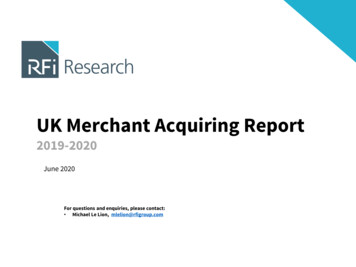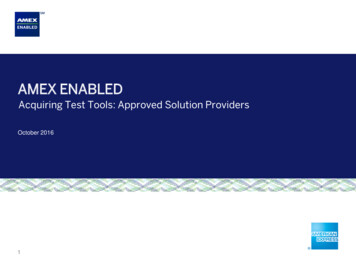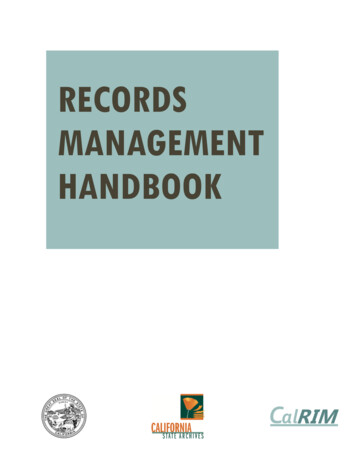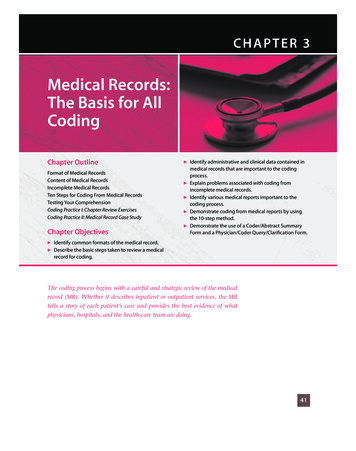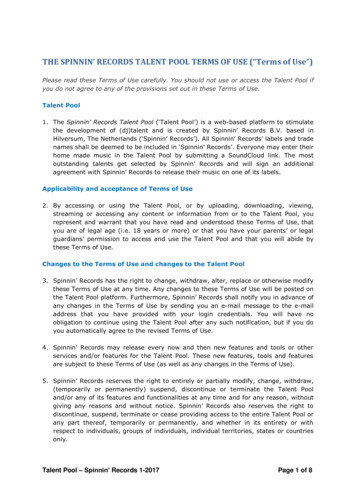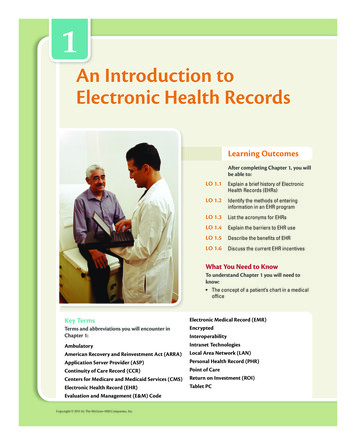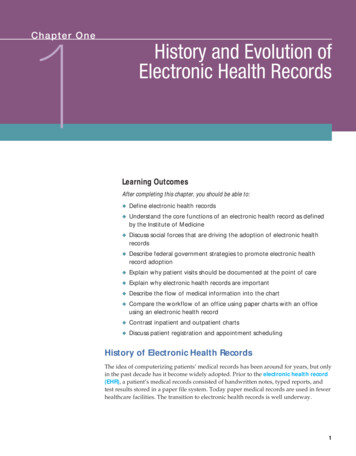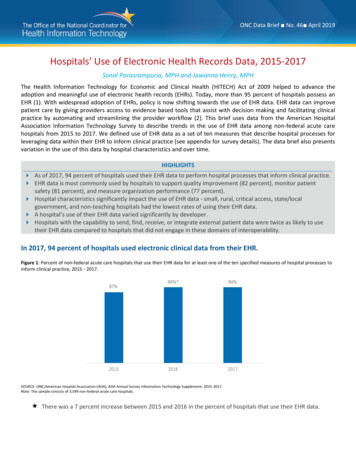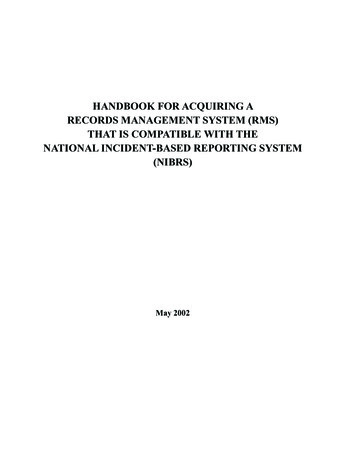
Transcription
HANDBOOK FOR ACQUIRING ARECORDS MANAGEMENT SYSTEM (RMS)THAT IS COMPATIBLE WITH THENATIONAL INCIDENT-BASED REPORTING SYSTEM(NIBRS)May 2002
TABLE OF CONTENTSINTRODUCTION1MAKE THE NIBRS RMS DECISION1.1Justification for System Change1.2Project Goals and Scope1.3Estimated Cost1.4Operational and Maintenance Costs and Options1.5Funding Options1.6Organizational Commitment1.7The Decision1.8NIBRS RMS Decisions, Lessons Learned155689101011112DEFINE THE RMS2.1Designate the Project Manager and RMS Team2.2Define the Agency’s Functional RMS Requirements2.3Define the System Requirements and Constraints2.4Define the RMS Interfaces2.5Define the RMS Operating Environments2.6Source Selection2.7RMS Definition, Lessons Learned15151723303131323DEVELOP COSTS AND FUNDING SOURCES3.1Cost Model Description3.2Additional Cost Analysis Considerations3.3Federal Funding Sources3.4Lessons Learned from NIBRS User and Vendor Communities37374647504SELECT RMS VENDOR4.1Define the Procurement Process4.2Define Acquisition Strategy4.3Develop RFP and Schedule4.4Conduct Source Selection4.5Sample RFPs4.6Procurement Lessons Learned535354566061615PLAN AND MANAGE IMPLEMENTATION5.1Establish Implementation Team5.2Prepare and Maintain Implementation Plan5.3Prepare and Maintain Risk Management Plan5.4Prepare O&M Budget5.5Hold Periodic Implementation Team Meetings5.6Plan and Manage System Security5.7Develop Interface Control Documents6566676969696971iii
5.85.95.105.115.12Convert FilesDevelop Test and Acceptance PlanDevelop Training PlanMonitor Vendor PerformanceImplementation Planning Lessons Learned71727576776INSTALL RMS6.1Site Preparation and Processor Installation6.2Prepare for Systems Operation6.3System Maintenance6.4Train Operations Staff6.5Oversee Integration Tests6.6RMS Installation Lessons Learned818183858686867AGENCY PREPARATION7.1Document Current Business Flow7.2Develop New Business Flow with NIBRS7.3Revise Policies and Procedures7.4Redesign Forms7.5Conduct RMS Acceptance Test7.6Prepare Each Operating Unit7.7Train Users7.8Convert to the New System7.9Agency Preparation Lessons Learned89899090919192939394Appendix A: Summary of Lessons LearnedTable A.1 Agency Lessons Learned SummaryTable A.2 State Program Lessons Learned SummaryTable A.3 Vendor Comments Summary9898104106Appendix B: NIBRS Data Elements AnalysisB.1Offenses Reported in NIBRSB.2Offense Lookup TableB.3Quality Control107107109126Appendix C: Cost Model User InformationC.1Cost Model StructureC.2Assumption in the Cost SheetsC.3Cost Model User GuideC.4Cost Model Variables131131133140145Appendix D: Commonly Used Acronymns151iv
INTRODUCTIONThis handbook has been developed under the sponsorship of the Criminal JusticeInformation Services (CJIS) Division of the Federal Bureau of Investigation(FBI) and the Bureau of Justice Statistics (BJS). It provides comprehensive, stepby-step guidance to local law enforcement agencies that are, or are considering,implementing an automated incident-based Records Management System (RMS)that is compatible and compliant with the National Incident-Based ReportingSystem (NIBRS).This handbook provides instructions on how to prepare for and conduct a systemacquisition and prepare the agency for conversion to the new system and toNIBRS. It includes lessons learned from other agencies and from vendors andpresents relevant templates and examples. The goal of this publication is to takethe guesswork out of purchasing a NIBRS-compliant RMS.The Need for Records Management Systems. Law enforcement agenciesmust maintain accurate, easily accessible records of the information that isrelevant to law enforcement and public safety in their community. Examples ofinformation maintained include names and addresses, incident and arrest data,case information, property and evidence data, information on permits, licensesand registrations, and crime statistics. Computer-based RMSs have been designedto help law enforcement personnel in these record-keeping tasks.There are many RMS vendors that offer a variety of commercial off-the-shelf(COTS) capabilities and features. Not every local agency will use one of theseCOTS products. Some very small local agencies have difficulty getting budgetapproval for the purchase of any automated system; some larger agencies havecustom-designed their own RMS to meet their unique needs. A law enforcementagency modernizing its record-keeping system must follow a careful path inchoosing a commercial system that best meets its individual needs. A first step, ofcourse, is understanding and documenting those needs.Incident-Based Reporting and RMS. In the majority of cases, law enforcementagencies report crime statistics to state agencies and the FBI, and the RMS mustsupport this procedure. Over 70 years ago, standards were established for theUniform Crime Reporting (UCR) Program so agencies could report their crimeand arrest information in the same format and at the same level of detail andaccuracy. Under the traditional UCR system agencies report monthly aggregatecounts for eight Index crimes. This is now referred to as Summary UCR.In 1989, the FBI instituted a new crime-reporting system called the NationalIncident-Based Reporting System to provide a more detailed and comprehensiveview of crime in the United States. Since many local law enforcement agenciescontinue using Summary UCR format, the FBI’s CJIS Division wants to aid these1
agencies in converting to NIBRS. Many of these agencies will have to makechanges in how crime information is collected, processed, reported, and howquality is controlled. And many may have to move to a new or upgraded RMS.NIBRS provides local agencies an enhanced picture of crime in their jurisdictions.Law enforcement agencies benefit in several ways from the detailed, accurate, andmore meaningful data that NIBRS produces. NIBRS data help in the effectiveallocation of resources in the war against crime. Armed with comprehensivecrime data, local agencies can better make their case to acquire the resourcesneeded to fight crime. Local agencies that are currently certified to report NIBRSin their state affirm that:û NIBRS improves crime classification processes.û NIBRS provides substantial investigative benefits, including better crimeanalysis and crime mapping.û NIBRS produces better information and a more readable report.û NIBRS offers automation opportunities for improved business flow withinthe agency and to other entities requiring complete incident data (e.g.,courts).û NIBRS improves community policing.û NIBRS promotes thorough crime scene data collection.NIBRS agencies also report that officers display a higher level of concern forvictims during the questioning necessary for completing an incident-based report.The participation of local law enforcement agencies in NIBRS is importantfor producing a highly accurate representation of crime. Crime data accuracyand completeness provide important snapshots of crime at all levels of lawenforcement: local, regional, state, and national. The crucial starting point of thiscrime reporting process is at the local level.This handbook provides law enforcement agencies a detailed map for convertingto a NIBRS-compliant RMS. It is a companion document to a cost model thathelps law enforcement agencies estimate the costs of implementing and operatingsuch a system. A prototype cost model was developed for the FBI and BJS asdocumented in Costs of Implementing and Operating a NIBRS Capable RecordsManagement System, (Mitretek Systems, 14 June 1999). This Excel-based costmodel has been updated through surveys of local and state agencies and vendorsof NIBRS-compliant RMSs. The cost model is flexible, accommodating agenciesof various sizes and levels of experience with incident-based reporting.The sections of this report correspond to the major activities involved in movingto a NIBRS-compliant RMS as described in the “Map to Handbook,” on the nextpage. Each section includes a summary of lessons learned, as provided by lawenforcement agencies that have already implemented, or are implementing, a2
NIBRS-compliant RMS, and by RMS vendors with experience in installing RMSsin agencies of various sizes.The report is comprehensive, in order to address the broad range of functionalneeds of large law enforcement agencies. However, in many of the sections, textthat provides guidance specifically designed for small agencies is emphasized in a“For a small agency” text box.Map to HandbookSection1234567TitleMake theNIBRS-RMSdecisionDefine the RMSDevelop Costsand FundingSourcesSelect RMSVendorPlan and ManageImplementationInstall RMSAgencyPreparationDescriptionDescribes the steps an agency should follow in deciding to usea NIBRS-compliant RMS and outlines information necessaryto make this decision.Describes the process for defining RMS capabilities andrequirements.Addresses how to estimate costs and describes other costand funding considerations.Addresses the specific procedure agencies should follow ifthey decide to use RMS vendors.Describes activities necessary for managing RMS andNIBRS implementation.Describes how to prepare for and install the new computerbased RMS.Provides a guide to prepare agencies to operate the newNIBRS-compliant RMS. Note: activities described insection 7 should be performed simultaneously with thosedescribed in sections 1 through 6.3
1MAKE THE NIBRS RMS DECISIONEach agency interested in acquiring a NIBRS-compliant RMS must initiallyassess the impact of converting from Summary UCR to NIBRS reporting. Notevery agency is prepared for making this conversion and maintaining the newsystem once it is implemented. This section addresses the major factors thatmust be considered in making the decision to proceed. The subsections belowaddress these factors:û Justification for system change.û Project goals and scope.û Estimated cost.û Operation and maintenance costs and options.û Funding options.û Organizational commitment.The decision process and the information supporting the final decision should beoutlined in a strategic plan. The strategic plan provides a high-level vision ofthe goals, scope, and projected benefits and costs of the new RMS project. Thisplan helps to explain the project to other organizations, gain the support of thecommunity, and justify the funding needed for implementation.1.1Justification for System ChangeAcquisition of a modern NIBRS-compliant RMS can be justified to thecommunity and potential funding sources by documenting the serious recordmanagement problems currently faced by the agency, showing how a NIBRScompliant RMS addresses those problems, and emphasizing additional benefits ofNIBRS. (See Table 1.1.)Depending on the scope of an agency’s RMS project, implementing the RMSin phases may be advisable, although it is certainly not required. Problems canbe prioritized so that the most important ones are addressed first, with lesserproblems addressed as funding and scheduling permit. Table 1.1 illustrates ahypothetical agency whose implementation is accomplished in phases and whosehigh priority problems include difficulty in cross-referencing names and addressesand excessive time needed to prepare incident reports.An agency can develop approaches for acquiring, implementing, and operating aNIBRS-compliant RMS, which alleviates these or other problems, by conversingwith other agencies and RMS vendors. This can help an agency define the goalsand scope of the RMS project, determine how the current records managementand reporting problems will be addressed by a new RMS, and quantify the amountof time and effort needed to complete the project.5
Table 1.1 Examples of Problems Addressed by a Modern RMS, Using a PhasedImplementation ApproachProblemSolutionPhase I:Inability to easily cross-reference names and addressesbetween files.Acquire an RMS with central name and address file.Time to prepare incident reports is too long with toomany errors.Acquire Automated Field Reporting module with entrylevel editing, etc. for use on mobile data computers.State and FBI crime reporting is time-consumingbecause of errors and cumbersome procedures.Acquire an RMS capable of accurate NIBRS reporting.Crime analysis is incomplete and inaccurate because ofincomplete data.Collect incident and arrest data that encompass NIBRSreporting requirements.Phase II:Case management files are manual and unwieldy.Acquire an RMS module with case managementsupport capability.Real time information (regarding calls for service) is not Provide report to each patrol shift showing all calls forreadily available for beat officers.service on their beat.Phase III:Evidence management is time consuming and prone toerrors.1.2Acquire property and evidence management module.Project Goals and ScopeOnce the agency knows what is achievable, the RMS project’s goals and scopecan be documented. Each goal should be related to an overall agency goal.Goals should be stated at a high level but should address specific problems orchallenges. For example, the agency’s goal might be:Improve community policing by modernizing our records systems to:û Allow officers to more readily identify and locate wanted individuals.û Provide officers with more time on the beat by reducing the time neededfor report preparation.û Assist officers in case investigations through the use of moderninformation storage and retrieval technology.û Provide officers with information about all recent incidents occurring ontheir beat.û Improve the safe management of evidence and other agency propertyû Improve crime reporting and be consistent with state and federalrequirements.6
As Table 1.1 exemplifies, the problems the agency currently faces and theshortcomings of current system help define the scope of the project. In additionto current problems and system limitations, the project’s scope is shaped byany system interfaces that are required. For example, if the agency already hasa viable case management system, then the project’s scope would not includea new case management capability. However, the new RMS may need tointerface with the legacy case management system and this requirement wouldneed to be in the project’s scope.Other boundaries of the system can be defined by how the new RMS is to relateto other systems or agencies. For example, it must be determined who will enterwarrant information. If the courts are to provide this information electronicallyto the RMS, then the electronic interface with the court system must be in theproject’s scope. Table 1.2 summarizes some of the broad range of functions thatmay be supported by a modern RMS.Table 1.2 Potential RMS �ûMaster name and address fileAutomated Field Reporting System supporting Mobile Data ComputersReports entry and processingBookingCrime analysisState and national NIBRS reportingManagement reportingCase managementProperty and evidence managementPawn trackingIntelligence supportCitation and traffic accident tracking and reportingAccess to state message switch for NCIC, NLETS, III, and state crimerecordsAccess to computer-aided dispatch (CAD) recordsAccess to geo-files of crime informationAccess to fingerprint identification system recordsAccess to or copies of vehicle registration files, drivers license files, courtfiles, Corrections files, probation files, etc.Registration and licenses management (gun registration, bike registration,hacker Licenses, etc.)Personnel administration and records maintenanceStaffing and scheduling administrationTraining administrationProperty inventory administration7
1.3Estimated CostIt is essential to estimate the cost of the new NIBRS-compliant RMS as partof the strategic plan. Fortunately, an agency can use an existing cost model tomake this preliminary cost estimate.In 1999, Mitretek Systems quantified the costs that law enforcement agenciescould expect to incur when implementing a NIBRS-compliant RMS. Fromthis, Mitretek developed a personal computer-based cost model with a simplegraphical user interface (GUI) for the FBI and BJS staff so that they canestimate the cost of an agency’s conversion to a NIBRS-compliant RMS.This cost model, which is based on Microsoft Excel , has been updated.Instructions have been developed so local law enforcement agencies can alsouse it. In general, the information needed to use the cost model includes theagency’s current state of technology (no RMS, non-incident-based RMS, orincident-based RMS), monthly incident rate, number of sworn officers, andsoftware acquisition preference (COTS or customized). (Section 3 of this reportfurther describes the cost model and its use in more detail.)The model generates a cost estimate for:û Software procurement.û Hardware procurement.û End user and system administrator training.û Installation services.û Data conversion services.û Annual operation and maintenance.For a small agency, the majorTo use the model for a multi-year project,costs are for the RMS and theagencies may need to allocate project costsdesktop computer that it uses.by year. For example, expenditures for thehardware and software may occur in one fiscal Vendors can provide estimatesfor annual maintenance costs.year, while the training, installation and dataconversion costs may be incurred the followingfiscal year. The operation and maintenance (O&M) costs will accrue for allyears following installation.If an agency adopts a phased implementation approach, the costs should beidentified for each phase. For example, if property management capabilities areadded in a later phase then costs of the property management software moduleand property file conversion should be attributed to that phase.8
1.4Operational and Maintenance Costs and OptionsPart of determining the feasibility of RMS and NIBRS implementation isaddressing how the system will be operated and maintained, and who will befiscally and operationally responsible. For annual fees, the hardware vendor canmaintain the hardware and the commercial RMS vendor the software. But thereare other O&M costs, including:û Data entry to maintain the RMS files.û NIBRS report preparation and quality control.û O&M of supporting systems such as communications networks, databasemanagement systems, power, air conditioning, etc.û Supplies.û System changes over time to meet the changing needs of the agency.(RMS vendors can quote prices to modify their software, but this practicehas serious implications.)û System administration and performance management.û Project oversight and quality control (to make sure implementation isbeing done well and on time).û Audits of update transaction logs and reviews of security and intrusionlogs.There are three operating options:1.Agency assumes responsibility. In this case, the agency musthire, train, and retain a staff with skills and knowledge needed forsystem O&M.2.Off-site Outsourcing. The agency contracts with anothergovernment agency or commercial firm to assume responsibilityfor O&M.3.On-site Integration Contractor. The agency contracts with acommercial firm to operate the system on the agency’s premises,supply the needed personnel, and take care of day-to-dayoperations.For a small agency, it may be worth considering having a nearby, larger lawenforcement agency operate the RMS. A downside of this is that a smalleragency’s requirements may be secondary to the larger agencies, forcing thesmaller agency to accept the system as it is. Another option is to join forceswith other nearby law enforcement agencies and jointly develop a sharedprocessing facility. A downside of this shared effort is that an agency mustbe able to work very closely with these other agencies through a sustained,intense effort. Unless a well-defined decision-making process exists, orunless one agency acts as the lead agency, the joint effort will tend to comeapart due to the strains of the effort.9
Outsourcing or integration contracting may be attractive alternatives if an agencyis unlikely to be able to staff RMS operations; howev
The Need for Records Management Systems. Law enforcement agencies must maintain accurate, easily accessible records of the information that is relevant to law enforcement and public safety in their community. Examples of information maintain
